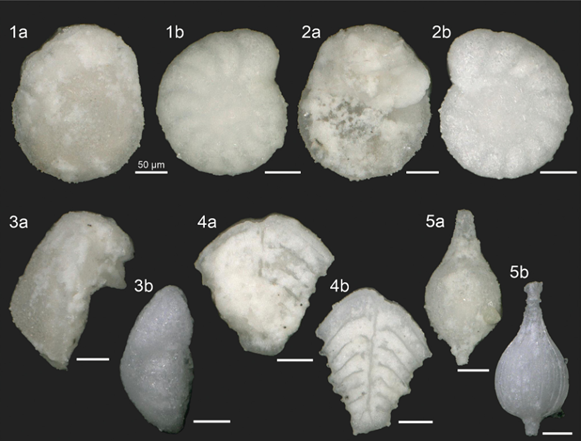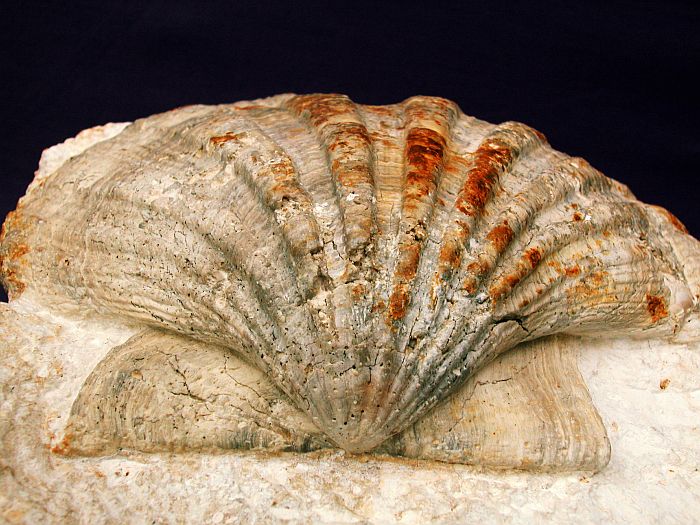
Paleontology
Paleontology investigates the history of life on our planet. The most important objects of research are fossils, which, as elements of a geological biosphere, provide very diverse evidence of the biodiversity and evolution of life on earth and its interaction with the climate and the environment:
- they document the development from simple to complicated blueprints (evolution),
- provide evidence of radiations and ecological crises (paleodiversity),
- allow a chronological classification based on their evolutionary development (biostratigraphy),
- can provide information about their habitat through their adaptations to the environment (palaeoecology),
- indicate spatial relationships (paleogeography) or former land bridges or sea passages (biogeography) through their distribution patterns,
- can contribute to deciphering past climates (palaeoclimatology)
Palaeontology is located at the intersection of biology and geology and thus spans the research field of geobiology. Findings from the biological sciences are synthesized with palaeontological data according to the principle of topicality (guiding principle: "The key to understanding the past lies in current processes"). Paleontology is linked to the geological sciences by the fact that the (paleo)biosphere becomes part of the lithosphere through fossilization processes and is stored in it as a document of the earth's history with a very long residence time.
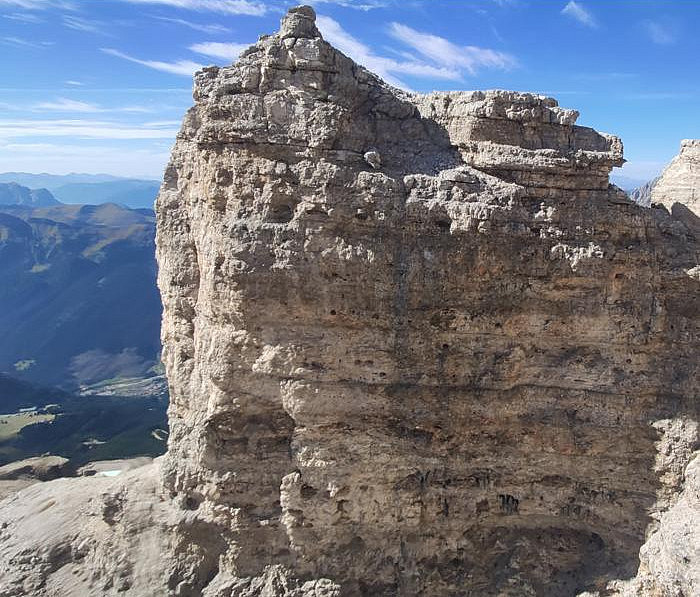
Stratigraphy
Stratigraphy investigates the (relative) temporal sequence of rock bodies and their spatial relationship (correlation) based on their organic and inorganic characteristics. Depending on the use of different time markers, a distinction is made between a number of sub-disciplines (e.g: Lithostratigraphy, biostratigraphy, sequence stratigraphy, magnetostratigraphy, chemostratigraphy, cyclostratigraphy), which, especially when used in combination, enable a detailed resolution of the earth's history. With the help of stratigraphic data, causal-analytical geodata are placed in an earth-historical context (historical geology). Stratigraphy thus forms the basis for placing rates of change in a temporal context. With its help, for example, the effects of climate change and evolutionary rates of organisms can be placed in a temporal and spatial context.
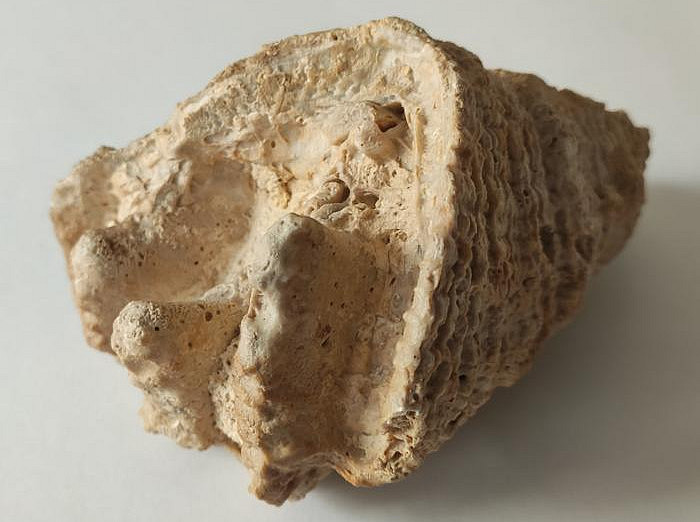
Geobiology and paleoclimatology
Geobiology is an interdisciplinary field of research that combines the methodological research approaches of the geosciences with those of the biosciences in order to explore cycles and material and energy flows between the biosphere and the lithosphere, hydrosphere and atmosphere. The aim is to draw a holistic picture of the Earth system and its spatio-temporal development.
Paleoclimatology explores the dynamics of climate and its effects on the Earth system over the course of the Earth's history. Earth history scenarios can be used as case studies of the effects of climate change on the Earth system and contextualize anthropogenic climate change, as well as improve models for future climate predictions.
The closely related research fields of geobiology and palaeoclimatology provide basic knowledge for understanding climate and environmental change in the context of the processes of the Dynamic Solid Earth. They also explain the patterns of biodiversity and evolution over the Earth's history and provide basic data for future predictions.

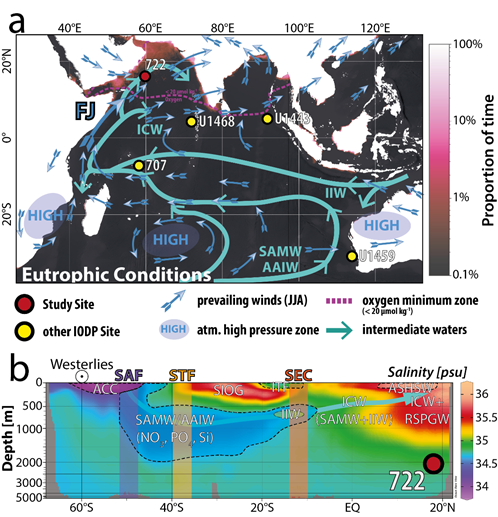
Gerald Auer
Project team: Tamara Hechemer (PhD student), Xabier Puentes Jorge (PhD student), Patricia Schilcher (project assistant) & Simon Schretter (project assistant, MSc student)
The Indian monsoon is one of the most influential weather systems on earth. Its seasonal winds bring rain to one of the most populated regions in the world. In addition to seasonal precipitation, the monsoon winds have another effect on the Indian Ocean: off the coast of the Arabian Peninsula, they displace water on the sea surface. This causes masses of water to rise from the depths of the ocean. This upwelling of nutrient-rich deep waters along the coast of Oman makes this area one of the most productive regions in the world's oceans.
Using microfossil and geochemical data trapped in fossils and sediments, MIO:TRANS will explore wind-driven upwelling of nutrient-rich water masses with nutrient and energy fluxes in the Indian Ocean during the Miocene, 7 to 15 million years ago. These objectives will be achieved by analyzing a transect of Ocean Drilling Project (ODP) deep-sea scientific wells across the Indian Ocean. The transect extends from 30° south to 20° north latitude to capture the entire oceanic and atmospheric circulation in the Indian Ocean.
Furthermore, MIO-TRANS sheds light on a transport pathway for marine nutrients through the deeper water masses of the Indian Ocean, which has hardly been explored in the geological past and extends to a depth of 1500 meters. The aim is to detect possible changes in nutrient transport through these deep waters that are linked to climate change in the higher latitudes of the Southern Hemisphere.
Publications
Bialik, O.M., Auer, G., Ogawa, N.O., Kroon, D., Waldmann, N.D., Ohkouchi, N., 2020. Monsoons, Upwelling, and the Deoxygenation of the Northwestern Indian Ocean in Response to Middle to Late Miocene Global Climatic Shifts. Paleoceanogr. Paleoclimatol. 35, e2019PA003762. https://doi.org/10.1029/2019pa003762
Auer, G., Bialik, O.M., Antoulas, M.-E., Vogt-Vincent, N., Piller, W.E., 2023. Biotic response of plankton communities to Middle to Late Miocene monsoon wind and nutrient flux changes in the Oman margin upwelling zone. Clim. Past 19, 2313-2340. https://doi.org/10.5194/cp-19-2313-2023
The Middle Pleistocene Transition on the Westcoast of Australia - Foraminifer Assemblages as tracers of past sea level and productivity changes.
Gerald Auer
Project team: Anna Arrigoni (PhD student)
The Middle Pleistocene Revolution, about a million years ago, is a reorganization of the global climate that is still poorly understood today and led to the appearance of the great ice ages of the Pleistocene. This change took place without external changes and is therefore an excellent example of a tipping point in the Earth's climate system.
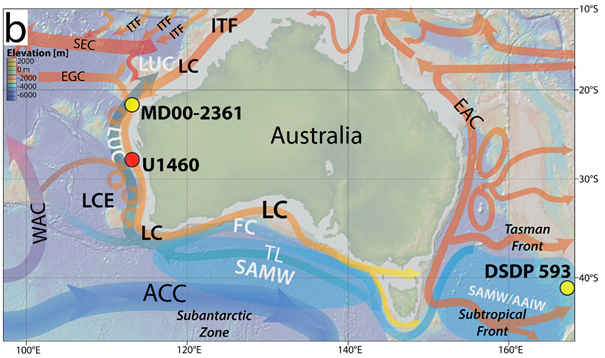
Our project investigates the effects that the crossing of this climatic tipping point had on marine ecosystems. The aim is to better understand the effects of strong sea level fluctuations on sensitive ecosystems in the ocean and their interaction with the carbon cycle. Fossil foraminifera, the remains of unicellular marine organisms, allow us to record these climate-driven changes in the ecosystem, and also to reconstruct local sea level fluctuations along the west coast of Australia. The research results of this project will thus provide insights into climate-driven changes in global ocean circulation and the carbon cycle.
Publications
Auer, G., Petrick, B., Yoshimura, T., Mamo, B.L., Reuning, L., Takayanagi, H., De Vleeschouwer, D., Martinez-Garcia, A., 2021. Intensified organic carbon burial on the Australian shelf after the Middle Pleistocene transition. Quaternary Sci Rev 262, 106965. doi.org/10.1016/j.quascirev.2021.106965
